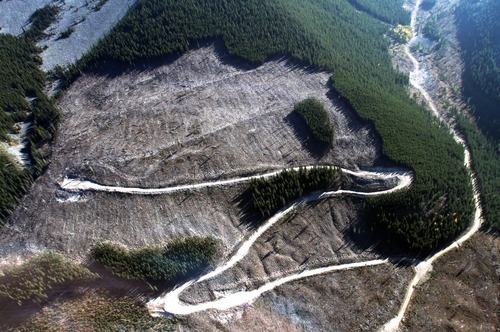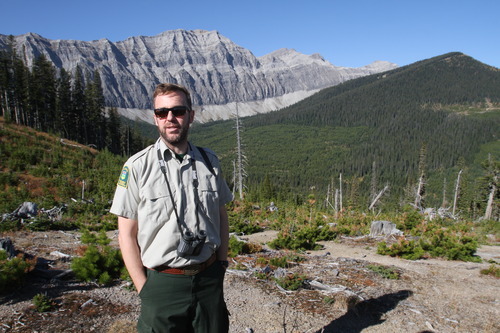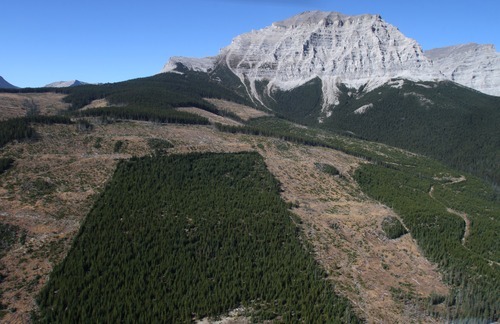This is an archived article that was published on sltrib.com in 2012, and information in the article may be outdated. It is provided only for personal research purposes and may not be reprinted.
Crowsnest Pass, Alberta • Helicopters swooped into the southern Canadian Rockies here almost as soon as mountain pine beetles landed.
Unlike to the north, where a freezing, continental "thermocline" until recently had blocked beetles from entering, this area north of Montana's Glacier National Park had seen tree-killing outbreaks before, most recently in the early 1980s.
It started again in 2004.
The beetles always had retreated before, but Alberta's foresters looked to the west — at the devastation they were leaving in British Columbia this time — and didn't take chances.
"Communities got lost in B.C.," said Brad Jones, southern area forest health officer for the Alberta Ministry of Environment and Sustainable Resource Development. "It's gone from grim to grimmer."
So Alberta spent tens of millions of dollars to find and burn every tree the beetles colonized. Helicopters, ATVs and ground crews delivered chain saws and torches to wherever they saw trees dying and turning red beneath the jagged gray peaks.
At the battle's height late in the past decade, these crews were finding, cutting, piling and, after snowfall, burning 35,000 trees a year. Each patch of infested pines cost $300 to survey and each tree at least $75 to destroy.
The work was urgent because if the beetles headed down the east slope of the Rockies, they would hit a carpet of pine all the way to Calgary. Such an onslaught could muddy that city's tap water because the trees protect that drinking supply by shading snow and preventing rapid, muddy runoff.
The Canadian Forest Service advised Alberta to strike while the beetle numbers were relatively small. With nature's help, it worked.
Fall 2009 proved mild, perhaps stalling the beetles' natural development for fighting cold. Then a minus-40 Celsius cold snap hit at Christmas, and the bugs spread slower in summer 2010. At Canadian Thanksgiving that October, a 20-below freeze hit earlier than usual.
Southern Alberta's outbreak was over.
"This approach works when the weather is there to help you," Jones said. "It's just a very expensive thing to do."
The eight-year effort has cost Alberta nearly $300 million, though the work has shifted north to the first-ever beetle incursion into the province's boreal forest. There, with the insects spreading faster and over a vast, relatively flat landscape, crews have targeted as much as five times what they ever cut in the south. But the outbreak there, in virgin territory, grows.
Look to the lab
Some of the trees lost around Crowsnest Pass were whitebark pines, which are collapsing across the West and now have legal protections in Canada. Jones presented his success story at a meeting of the Whitebark Pine Ecosystem Foundation last year in Wyoming, where retired U.S. Forest Service entomologist Jesse Logan warned him that, long term, there's no blocking the bugs.
Logan explained this month that once the climate reaches a "tipping point," allowing beetles to survive winters in new territory and reproduce faster, there's no eradicating them. Weather can knock them back, he said, but vast new territories — all the way to the Eastern Seaboard — are now primed for the next outbreak.
The whitebark's best hope, Logan said, might be in the lab, not the burn pile. He suggests that the U.S. and Canadian governments push to identify individual whitebarks that are especially beetle-resistant, then use them as a seed source. It could be a way of speeding a natural evolution, which the tree may not have time to make on its own.
"That's an honest hope," Logan said. "The research should be going on right now. It should've started five years ago, when we realized this [outbreak] was something different."
Alberta's aggressive beetle hunting is far more optimistic than anything the U.S. Forest Service is trying. Rather than halting the insects, U.S. foresters are trying to keep them out of the most sensitive places.
In some cases that means thinning trees or hosing insecticides around crucial watersheds. In others it means chemically protecting big trees around popular campgrounds and trails.
Across most of the American Rockies the outbreak crescendoed so quickly that there was no stopping it until places such as Helena, Mont., had virtually no mature pines left. In Utah, Forest Service entomologists say the outbreak is slowing only because suitable host trees are mostly gone.
The forests will regrow, most experts agree, but changing habitats will mean a new mix of species. Where they regrow, it will take decades (lodgepole pines) or centuries (spruces and whitebark pines) for recognizable Western woods to mature.
As with human health, Forest Service entomologist Liz Hebertson said, "early detection and rapid response" are best.
"Prevention is always the most cost-effective way of dealing with things," she said. But Utah's outbreak has metastasized beyond that point, so her agency is focused on saving places such as the Cottonwood canyon ski areas and picnic grounds.
Gaining ground
Alberta foresters believe they're in a better position to think bigger. They laser in on landscapes, not landmarks.
The province is trying to save its watersheds and ecology, not just its pretty places, said Erica Samis, Alberta's forest health chief. Having learned from British Columbia's losses, she won't send crews to cut trees unless they're likely to stop 80 percent of the beetles. Anything less allows an exponential growth to continue and is a waste.
"It's a hard decision," Samis said, "but make sure you walk away where you can't make a difference."
In southern Alberta, at least, officials see their money as well-spent. The province offered The Salt Lake Tribune a helicopter flight to survey the results.
Setting down by a hilltop pile of downed, de-barked whitebark pines south of Banff National Park, Jones recalled the urgency of killing the beetles that had attacked. A contractor had won a bid to cut and burn the trees, but then failed to get the job done before springtime brought too much fire danger to set any blazes.
The province quickly awarded a contract to a new company, needing to kill the beetles before the next generation could fly off in July. Workers hiked in, hacked trees into 4-foot lengths and scraped drawknives across them to remove the bark and the unprepared beetles.
The gray logs remain there in a jumble, like firewood delivered and waiting to be stacked. In the clearing around them, a new crop of knee-high trees is taking their place.
Twitter: @brandonloomis









